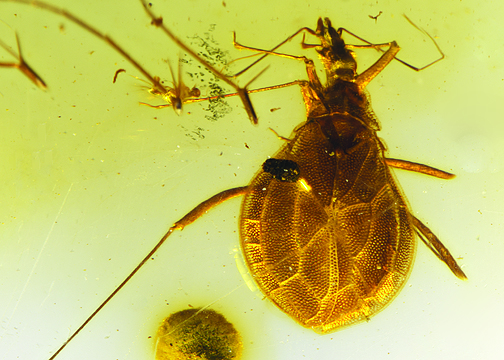Abstract
Tingidae are also known as ‘lace bugs’ because of the delicate, lace-like appearance of their pronotum and hemelytra. Currently, lace bugs (Heteroptera: Cimicomorpha: Tingidae) comprise approximately more than 2,613 species are placed in about 318 genera (Schuh & Weirauch, 2020), they are extremely important phytophagous pests from all over the world (Drake & Davis, 1960; Drake & Ruhoff, 1965). Tingidae are classified into three extant subfamilies: Tinginae; Cantacaderinae; Vianaidinae, and one extinct subfamily: Tingiometrinae. To date, 46 genera with 82 species of Tingidae are known in the fossil record (Wang et al., 2021; Kaulfuss & Heiss, 2023; Ross, 2024). The subfamily Tinginae comprises 29 genera and 46 species, Cantacaderinae includes 6 genera and 18 species, Vianaidinae consists of 2 genera and 2 species, Tingiometrinae contains 2 genera and 5 species and 7 genera and 11 species remain unassigned to any subfamily (Schuh et al., 2006; Heiss et al., 2015; Du & Yao, 2018; Popov & Golub, 2019; Golub & Heiss, 2020; Poinar & Vega, 2020; Golub et al., 2021; Wang et al., 2021; Ross, 2024), ranging from the Early Cretaceous to the Miocene. Archetingis ladinica Montagna et al., 2018, the earliest fossil record of the Tingidae is from the Middle Triassic in Switzerland, but its classification remains controversial (Wang et al., 2021).
References
- Drake, C.J. & Davis, N.T. (1960) The morphology, phylogeny and higher classification of the family Tingidae, including the description of a new genus and species of the subfamily Vianaidinae (Heteroptera). Entomologia Americana, New Series, 39, 1–100.
- Drake, C.J. & Ruhoff, F.A. (1965) Lacebugs of the world: a catalog (Tingidae). Bulletin of the United States National Museum, 243, 634 pp. https://doi.org/10.5479/si.03629236.243.1
- Du, S.L. & Yao, Y.Z. (2018) A new genus and species of Tingidae (Heteroptera: Cimicomorpha) from Myanmar, with the analysis of the evolution of hood, carinae and paranota. Zoological Systematics, 43 (3), 283–293. https://doi.org/10.11865/zs.201828
- Golub, V.B. & Heiss, E. (2020) Three new species of the lacebug genus Tingiometra from Cretaceous Burmese amber (Hemiptera: Heteroptera: Tingidae: Tingiometrinae). Zootaxa, 4767 (4), 531–542. https://doi.org/10.11646/zootaxa.4767.4.3
- Golub, V.B. & Popov, Y.A. (2000) A remarkable fossil lacebug from Upper Cretaceous New Jersey amber (Heteroptera: Tingoidea: Vianaidinae), with some phylogenetic commentary. In: Grimaldi, D. (Ed.), Studies on fossils in amber, with particular reference to the Cretaceous of New Jersey. Backhuys Publishers, Leiden, pp. 231–239.
- Golub, V.B., Perkovsky, E. & Vasilenko, D. (2021) A new fossil species of the genus Parasinalda Heiss & Golub (Hemiptera: Heteroptera: Tingidae) from Upper Eocene Rovno amber. Zootaxa, 5027 (2), 290–296. https://doi.org/10.11646/zootaxa.5027.2.9.
- Guilbert, E. (2012) Phylogeny of Cantacaderinae (Heteroptera: Tingidae) revisited after the description of a new genus and new species from New Caledonia. European Journal of Entomology, 109, 111–116. https://doi.org/10.14411/eje.2012.014
- Guilbert, E., Damgaard, J. & D’Haese, C. (2014) Phylogeny of the lacebugs (Insecta: Heteroptera: Tingidae) using morphological and molecular data. Systematic Entomology, 39, 451–441. https://doi.org/10.1111/syen.12045
- Heiss, E., Golub, V.B. & Popov, Y.A. (2015) A new subfamily, genus and species of Tingidae (Hemiptera: Heteroptera) from Burmese amber. Zeitschrift der Arbeitsgemeinschaft Österreichischer Entomologen, 67, 1–9.
- Kaulfuss, U. & Heiss, E. (2023) The first fossil lace bug (Heteroptera: Tingidae) from New Zealand. Alcheringa: An Australasian Journal of Palaeontology, 47, 117–121. https://doi.org/10.1080/03115518.2023.2185678
- Lis, B. (1999) Phylogeny and classification of Cantacaderini [= Cantacaderidae stat. nov.] (Hemiptera: Tingoidea). Annales Zoologici, 49 (3), 157–196.
- Montagna, M., Stada, L., Dioli, P. & Tintori, A. (2018) The Middle Triassic Lagerstätte of Monte San Giorgio reveals the oldest lace bugs (Hemiptera: Tingidae): Archetingis ladinica gen n. sp n. Rivista Italiana di Paleontologia e Stratigrafia, 124 (1), 35–44. https://doi.org/10.13130/2039-4942/9623
- Poinar, G. & Vega, F. (2020) A lacewing bug, Paleoanomala aptenus gen. et sp. nov. (Hemiptera: Tingidae), in mid-Cretaceous Burmese amber. Biosis: Biological Systems, 1 (2), 65–71. https://doi.org/10.37819/biosis.001.02.0057
- Ross, A.J. (2024) Supplement to the Burmese (Myanmar) amber checklist and bibliography, 2023. Mesozoic, 1 (1), 21–57. https://doi.org/10.11646/mesozoic.1.1.4
- Popov, Y.A. & Golub, V.B. (2019) A new tribe, genus and four species of lace bugs (Hemiptera: Heteroptera: Tingidae) from the Upper Cretaceous of Southwestern Kazakhstan. Paleontological Journal, 53, 155–164. https://doi.org/10.1134/S0031030119010088.
- Schuh, R.T., Cassis, G. & Guilbert, E. (2006) Description of the first recent macropterous species of Vianaidinae (Heteroptera: Tingidae) with comments on the phylogenetic relationships of the family within the Cimicomorpha. Journal of the New York Entomological Society, 114, 38–53. https://doi.org/10.1664/0028-7199(2006)114[38:DOTFRM]2.0.CO;2
- Schuh, R.T. & Weirauch, C. (2020) True bugs of the world (Hemiptera: Heteroptera): classification and natural history. (Second Edition). Siri Scientific Press, Manchester, 768 pp.
- Wang, Y.X., Tang, H.Y., Ren, D. & Yao, Y.Z. (2021) New fossil Tingidae (Hemiptera: Heteroptera) from the mid-Cretaceous of Myanmar, with remarks on the phylogenetic relationships within the family. Insects, 12 (10), 887. https://doi.org/10.3390/insects12100887


